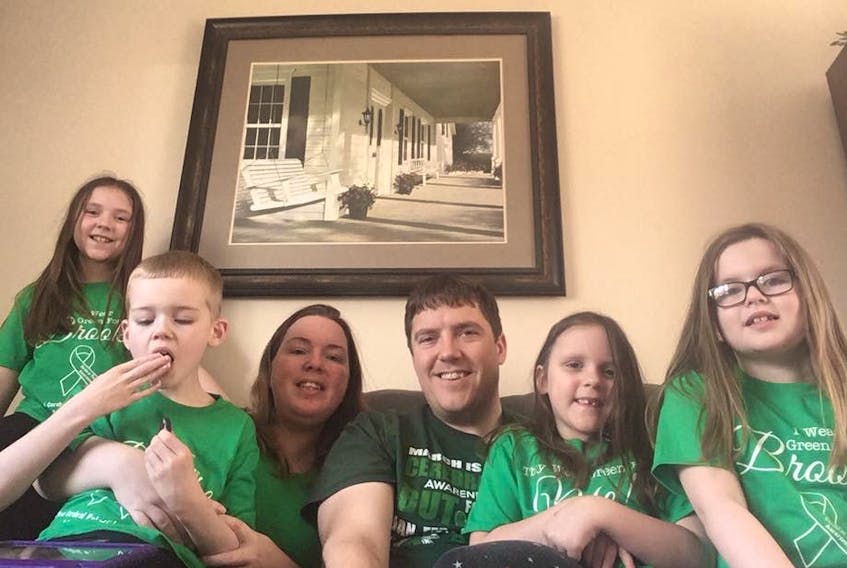Connor Patey's day is usually different from most children. The eight-year-old has been diagnosed with autism, but the spectrum is so broad that each child requires different care or faces different challenges.
“Connor has very little awareness of safety, so a lot of our day revolves around making sure that he’s safe,” said his mother, Amanda Patey. “That’s the first and foremost.”
Connor is also very minimal when it comes to communication, using mostly one or two-word sentences. His sleeping habits are erratic and require medication.
“Children with autism … their bodies don’t produce melatonin like ours do so therefore their body doesn’t require as much sleep,” explained Amanda. “They can run on very little sleep.”
In order to keep Connor in bed during rest hours, the family uses a special clock to help him understand time.
“We have a clock. Blue means it’s bedtime. You have to stay in bed.”
When the clock turns orange at 7 a.m., Connor can get out of bed. Patey says Connor has become very adjusted to the clock and usually stays in his bed even if he wakes early when the clock is still blue. It is these little things that really help Connor.
“A typical day has got to be very routine. Routines work best for him.”
"It can be very straining when you can't go do things as a family because you really don't know how it's going to go." - Amanda Patey
Getting ready for school presents more challenges. Connor’s pull ups must be changed before he can be dressed.
“We haven’t had any luck with training him yet.”
Then Amanda tends to let him choose his own breakfast, since he only likes certain foods and textures. In the vehicle, Connor must sit in a particular seat for the ride to school, and during his lunch break he will come home and eat before playing on his iPad. Following the afternoon session, he’ll come home from school and retreat to his room for another sensory break.
“He’s actually doing fairly well. He does have a bit of issues at times because he’s very sensory and certain sounds and certain pitches of sounds really bother him.”
Amanda praises the school and staff for providing tools and resources Connor can use when he gets upset. She says all of the schools in the smaller communities they’ve resided have helped Connor with his social and development skills, and he’s been happier as a result.
Connor’s upsets are not confined to school. At home, sometimes even the noise from the dishwasher or microwave will bother Connor. Then there’s going out, even to run simple errands, something most people take for granted.
Amanda talked about a recent trip to Stephenville where she had no choice but to take Connor into the store to wait for his six-year-old sister Natalie, who needed to use the washroom. Connor had a meltdown and collapsed to the floor.
“It was very difficult to see him go through that and go through it myself,” admitted Amanda. “There was lots of people staring, and I completely understand why people would stop and look. It’s natural for people to do that, but it was very hard at the same time because people don’t understand by looking at him necessarily that he has autism and that’s a meltdown. What they see is a little boy on the floor crying, refusing to get up and me trying to pick him up and trying to stop him from running away from me.”
Amanda says she worries about Natalie, who she believes also feels the effects of dealing daily with her brother’s autism.
“She sees how Connor gets a little bit of different treatment,” said Amanda. “How come he gets to go and eat wherever he wants to, and I have to sit down to the table?”
And while most siblings their ages would play together, Patey says Natalie is growing up pretty much by herself because Connor won’t play with her. At only 6 she’s still too young to truly understand why even though she knows her brother is different.
Then there’s stress on her relationship with her boyfriend, Chris. Cooperation, strength and routine are the keys, says Amanda, because the couple finds it hard to carve out alone time. Connor doesn’t like to be around crowds, so that means not going out to dinner or other events unless the couple take turns and do things separately, such as spend time out with Natalie.
“Us as a family miss out on a lot,” admitted Amanda. “It can be very straining when you can’t go do things as a family because you really don’t know how it’s going to go.”
Originally from Isle aux Morts, Amanda relocated to Burgeo to be with Chris. That relocation has taken her away from much of her old support system. So far, she has only spoken briefly to one other parent in Burgeo who has a child with autism. She would love to have more support in her area but knows that is not easily done.
“A lot of times other people find it very hard to be able to take care of Connor because there’s so much requirements to do so. It’s not like babysitting a typical child, I’ll say.”
When it comes to treatment, she is debating doing more applied behaviour analysis (ABA) with Connor. She says it has brought him a long way in the past, but it does mean more time restrictions for her or Chris since a guardian has to be present while Connor is being treated.
“If government was going to spend money, the ABA program should be increased to include more social skills in everyday living and the therapists should be able to take children out in society to teach these skills.” — Joan Chaisson, co-founder of AIM (Autism Involves Me)
And as Connor gets older, the hours he could qualify for ABA are reduced. Finding a regular therapist in a remote community willing to work for only 10 hours a week is all but impossible, and Amanda says 10 hours is also not much time for treatment.
Amanda would like to see the government take another look at tweaking the ABA program to benefit not only the children with autism, but also the rest of the family. Although she says people are supportive and kind, they don’t always truly understand unless they go through it themselves. She believes kits with some simple tools for families to access, such as weighted blankets, would make a difference.
“If the government were to give those kinds of things to small communities, and especially isolated ones, and things like that, it would be very beneficial to the families that would seek those things,” said Amanda.
Naturally Patey is concerned about Connor’s future. She admits she feels a bit alone and will likely have to do a great deal of research in the future to see how best to help her son.
“I really don’t know what’s out there in terms of children like Connor who don’t really have a lot of verbal skills and social skills, how they would transition them into the real world, we’ll say. But I would love personally to know what is out there and what can be out there to make the transition from childhood to adulthood as easy as possible for him.”
Joan Chaisson is the co-founder of AIM (Autism Involves Me), which works with the Autism Society of Newfoundland and Labrador. AIM helps families from Rose Blanche to South Branch but is based in Port aux Basques. Burgeo and other smaller communities on the southwest coast are a bit out of their area, although Chaisson says they would help in any way to anyone who reaches out.
“I do a lot of consulting by Facebook messaging with parents outside of Port aux Basques,” said Chaisson, who does not diagnose children or draw up school programs. “If a parent has a question, they will ask me, and I will try to find out the answer or try to find the materials for them. I do a lot of research to give them ideas of where to look for more information.”
When she is able, she also provides packages when she’s able so that parents can work with their children at home to try to develop social skills.
Chaisson also believes the government could do a bit more to help, simply by streamlining and releasing more data. Current data reveals Newfoundland and Labrador has the highest ratio of children on the spectrum in Canada – 1 in 57 – which she thinks is actually higher on the west coast. But there are no breakdowns for children on the west coast because of privacy concerns. Chaisson says it is hard to advocate for proper funding, programs and class size without more data.
“If government was going to spend money, the ABA program should be increased to include more social skills in everyday living and the therapists should be able to take children out in society to teach these skills.”
Parents could simply sign a waiver granting authority to a trainer, says Chaisson, who also believes ABA training should last through grade 12.
Like Amanda, Chaisson is also concerned about children on the spectrum as they move to adulthood.
“There has to be much work done on what is going to happen to all these children once they become adults and have aging parents. We cannot wait for this to happen before government starts to act upon this.”
Twitter: @tygerlylly









